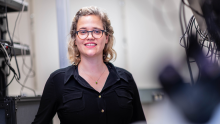New UBC research has literally and figuratively poked holes in single-band Hubbard physics--a model that has been used to predict and calculate the behavior of high-temperature superconductors for 20 years.
The findings are the first compelling evidence challenging the model under certain conditions, and could necessitate entirely new theoretical approaches to explaining superconductivity in cuprate materials, one of the outstanding mysteries in condensed-matter physics. "Single-band Hubbard physics has been used for 20 years to predict how superconducting cuprate materials accommodate the 'holes' left by electron removal," says Darren Peets, lead author of the study who conducted the research while a UBC doctoral student. "But now it looks like the approaches that underpin a large fraction of the theoretical work in the field just don't work across all the ranges of superconductivity we can study. The part of the cuprates' superconducting phase diagram we looked at could exhibit less-bizarre behaviour, or we could be seeing completely new physics, but in either case the usual theoretical approaches do not work here."
The findings were published today in the journal Physical Review Letters.
Cuprates normally act as insulators but become superconductors when electrons are removed--a process known as 'doping' holes into the material. Physicists consider a material optimally doped when it achieves superconductivity at the highest, most accessible temperature.
UBC researchers where able to break the single-band Hubbard model by 'overdoping' a crystal cuprate superconductor past its optimal range--a level of doping that is difficult to achieve and very rarely studied. While the model explains the material's electron behaviour during doping, Peets and his team found the model falls apart as even more electrons are removed.
"By probing the electronic states using tunable-energy X-rays, we were able to show that this region accommodates electron holes in a fundamentally different manner, and that the interactions among the holes already in the material change completely."
Special crystal samples grown at UBC enabled the team to overdope the superconductor to a degree rarely possible with most materials. "Few materials exist in this doping range, and they tend to be very difficult to grow crystals of," says Peets. "In the case of these crystals, thallium oxide--which is toxic--boils off near growth temperatures if you allow it. So a fair bit of work and care is required."
Discovered in 1986, high-temperature superconductors are cuprates--copper oxides. The materials, which exhibit superconducting properties at usually cold temperatures--often in excess of 90 kelvin--remain an enigma despite intense scrutiny. And because their superconducting state persists at more manageable temperatures, more commercial applications are feasible.
Peets, currently a post-doctoral researcher at Kyoto University, conducted the research at the Berkeley Advanced Light Source synchrotron under the supervision of UBC Physics and Astronomy Professor Douglas Bonn, and with UBC chemist and physicist Professor George Sawatzky.
The work was supported by the Natural Sciences and Engineering Research Council of Canada, the Canada Research Chairs program, the British Columbia Synchrotron Institute, and the Canadian Institute for Advanced Research.
Musqueam First Nation land acknowledegement
We honour xwməθkwəy̓ əm (Musqueam) on whose ancestral, unceded territory UBC Vancouver is situated. UBC Science is committed to building meaningful relationships with Indigenous peoples so we can advance Reconciliation and ensure traditional ways of knowing enrich our teaching and research.
Learn more: Musqueam First Nation
Faculty of Science
Office of the Dean, Earth Sciences Building2178–2207 Main Mall
Vancouver, BC Canada
V6T 1Z4


